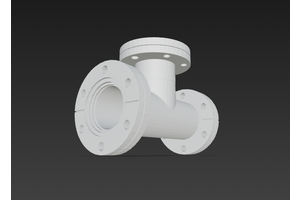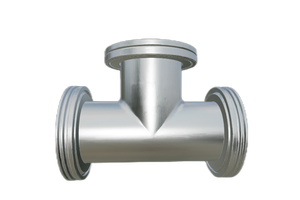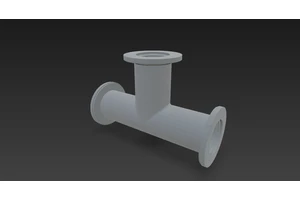-
The Basics of Vacuum Technology: Principles and Definitions
Vacuum technology is the science and engineering of creating, maintaining, and using environments with lower-than-atmospheric pressure. It is a critical foundation for industries ranging from semiconductor manufacturing to aerospace research. By understanding the principles of vacuum and how it relates to gas pressure, we can see why this technology is so vital for modern industry.What Is Vacuum Technology?At its core, vacuum refers to the absence or near-absence of gas molecules in a space. Normal air at sea level has a pressure of about 1013 mbar (760 Torr). When gas molecules are removed, the pressure decreases, and a vacuum is created. The deeper the vacuum, the fewer molecules remain.Levels of VacuumRough Vacuum (10³ to 1 mbar):Used in industrial processes like packaging and drying.High Vacuum (10⁻³ to 10⁻⁷ mbar):Required for processes such as thin-film deposition.Ultra-High Vacuum (10⁻⁷ mbar and below):Necessary for semiconductor fabrication, surface science, and particle acceler
View -
The Concept and Classification of Vacuum Technology
Concept of Vacuum TechnologyVacuum technology refers to the science and engineering methods used to create, measure, and maintain environments with air pressure lower than the atmosphere. In such conditions, the number of gas molecules is greatly reduced, which allows processes and experiments that cannot be performed under normal pressure. Vacuum technology is essential in many modern industries, including electronics, aerospace, materials science, medical devices, and scientific research.Classification of Vacuum TechnologyVacuum technology is commonly classified according to the pressure range and the methods used to achieve it. The main categories include:Low Vacuum TechnologyPressure slightly lower than atmospheric pressure.Often achieved with simple pumps.Applications: food packaging, vacuum molding, basic drying processes.Medium Vacuum TechnologyReaches pressures much lower than low vacuum.Requires more advanced pumps such as rotary pumps or mechanical boosters.Applications: coat
View -
Key Considerations When Selecting a Vacuum Pump
Choosing the right vacuum pump is critical to ensuring optimal performance, process stability, and equipment longevity. The selection process involves more than just meeting vacuum level requirements—it also requires evaluating environmental factors, gas composition, operational conditions, and maintenance needs. Below are the essential factors to consider when purchasing a vacuum pump:1.Vibration ImpactAssess whether the pump’s vibration during operation will affect your process or surrounding environment. If vibration is unacceptable for your application, choose a vibration-free pump or implement anti-vibration measures.2.Gas CompositionUnderstand the composition of the gas to be pumped—whether it contains condensable vapors, particulate matter, or corrosive substances. This will determine the appropriate pump type. If the gas contains vapors, dust, or corrosive gases, install auxiliary equipment such as condensers or filters at the pump inlet to protect the pump and ensure performan
View -
Working Principle of a Reciprocating Vacuum Pump
Areciprocating vacuum pump, also known as apiston-type vacuum pump, is one of the common devices used to obtain low vacuum. Compared with a rotary vane vacuum pump, it can be designed with a larger pumping speed. Compared with a liquid ring vacuum pump, it generally offers slightly higher efficiency. However, reciprocating pumps also have some drawbacks, including a more complex structure, larger size, and significant vibration during operation. In many applications, they can be replaced by liquid ring vacuum pumps.Structure and ComponentsA reciprocating vacuum pump typically consists of the following main parts:Cylinder– The chamber where the piston moves back and forth.Piston– Performs the reciprocating motion to create suction and compression.Crank and Connecting Rod Mechanism– Converts the rotary motion of the motor into the linear motion of the piston.Suction Valve– Allows gas to enter the cylinder from the vessel being evacuated.Exhaust Valve– Releases compressed gas from the cyl
View -
The Development History of Scroll Vacuum Pumps
The concept of scroll technology dates back to 1905, when French engineer Léon Creux filed a U.S. patent for a reversible scroll expander. However, due to the limited machining and manufacturing capabilities of the time, the precision required for the scroll plates and their spiral profiles could not be achieved. As a result, scroll machinery could not be produced for several decades.In the 1970s, the situation changed dramatically. The energy crisis, combined with the emergence of high-precision CNC machine tools, created new opportunities for scroll technology. In 1973, the U.S. company Arthur D. Little (A.D.L.) released its first research report on a scroll-type nitrogen compressor, highlighting advantages that conventional compressors could not match. This marked the beginning of rapid large-scale development and commercialization of scroll compressors.Rise of Scroll Vacuum PumpsWith the rapid growth of industries such as semiconductors, new materials, and biopharmaceuticals—and th
View -
Structure and Working Principle of Turbomolecular Pumps
A turbomolecular pump is a type of vacuum pump that uses high-speed rotating blades (rotors) to transfer momentum to gas molecules, creating a directional flow and thus evacuating the chamber. The main advantages of turbomolecular pumps include rapid startup, resistance to various types of radiation, durability under atmospheric exposure, no gas storage or desorption effects, minimal or no oil vapor contamination, and the ability to achieve clean ultra-high vacuum. These pumps are widely used in high-energy accelerators, controlled thermonuclear fusion devices, heavy-ion accelerators, and the manufacturing of advanced electronic components.Development HistoryIn 1958, W. Becker of the Federal Republic of Germany introduced the first practically viable turbomolecular pump. Since then, various designs have emerged, with the most common being vertical and horizontal configurations.A turbomolecular pump generally consists of the pump body, a rotor with blades (dynamic blades), stator blades
View -
Types of Dry Vacuum Pumps in Semiconductor Manufacturing: A Comparative Analysis
Dry vacuum pumps play a critical role in semiconductor manufacturing, where clean, oil-free environments are essential for high-precision processes. Over the past decade, advancements in mechanical design have led to the development of several dry vacuum pump types, each with unique advantages and limitations. This article explores the key categories of dry vacuum pumps used in semiconductor applications and provides guidance for selecting the most suitable design based on process requirements.1. IntroductionDry vacuum pumps are engineered to eliminate oil contamination, making them ideal for sensitive semiconductor processes. These pumps are broadly classified into two categories:multi-stage pumps(e.g., vane, claw, and combi-type) andsingle-stage pumps(e.g., screw-type).Multi-stage pumps rely on multiple vacuum chambers to compress gas incrementally, achieving high vacuum levels but requiring precise control of gaps and nitrogen dilution.Single-stage pumps, such as screw-type des
View -
Oil-Free Scroll Vacuum Pumps: Key Features and Industrial Applications
A clean vacuum environment has long been the gold standard for scientific research and industrial processes. Since the invention of vacuum technology, engineers and researchers have continuously sought methods to achieve contamination-free vacuum conditions. Today, a range of oil-free vacuum pumps exists, including condensation pumps, piston pumps, claw pumps, scroll pumps, and diaphragm pumps. Among these,oil-free scroll vacuum pumpsstand out for their unique advantages, making them a preferred choice in demanding applications.Key Features of Oil-Free Scroll Vacuum PumpsOil-Free and Frictionless OperationThe vacuum chamber operates without oil, ensuring non-contact operation between components. This eliminates mechanical wear and particulate contamination, providing an ultra-clean vacuum environment ideal for sensitive processes.High Pumping CapacityEquipped with dual scroll disks, these pumps offer double the pumping volume compared to single-stage models of the same d
View -
Key Considerations for Selecting a Vacuum Pump
When selecting a vacuum pump for industrial or scientific applications, it is critical to evaluate various technical, environmental, and economic factors. Below are essential guidelines to ensure optimal performance and compatibility with your specific requirements:1. Vibration and Environmental ImpactVibration Sensitivity: Assess whether the pump’s vibrations could interfere with the process or surrounding environment. If the application requires minimal vibration (e.g., precision manufacturing or laboratory settings), opt for oil-free or low-vibration pumps. Anti-vibration mounts or isolation systems can mitigate this issue in other cases.2. Gas Composition AnalysisGas Type and Properties: Identify the composition of the gas being extracted. Key factors include:Condensable Vapors: Gases like water vapor may require condensers to prevent clogging or damage.Particulate Matter: Dust or granular particles necessitate pre-filtration systems (e.g., dust collectors) to protect the pump.Corr
View -
Principles of Vacuum Pump Selection and Relevant Calculation Formulas
Before delving into the selection process for vacuum pumps, it's crucial to understand several fundamental concepts:Basic ConceptsVacuum Level: Represents the thinness of gas in a vacuum state, typically measured as vacuum level. The value read from a vacuum gauge is called vacuum level or gauge pressure. This indicates how much lower the system pressure is compared to atmospheric pressure (usually 101325 Pa). For instance, water ring vacuum pumps can achieve an ultimate absolute pressure of about 3300 Pa, whereas rotary vane pumps reach approximately 10 Pa.Ultimate Relative Pressure: Refers to the internal pressure difference relative to "atmospheric pressure". When using relative or gauge pressure, negative signs precede the values because the internal pressure is always lower than the external pressure.Ultimate Absolute Pressure: Compares the internal pressure with the theoretical vacuum (0 Pa). Due to technological limitations, achieving absolute vacuum is impossible; thus, the vac
View
Vacuum Pump




